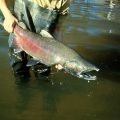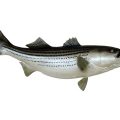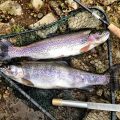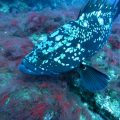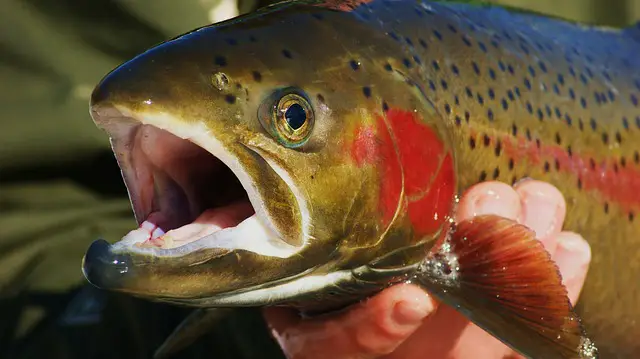
Steelhead is
a kind of rainbow trout which migrates up the rivers to lay or deposit eggs but
deep into the sea to live permanently. Their shapes are significantly different
from those of their freshwater counterparts.
Their bodies
are generally streamlined, hydrodynamic, and more pronounced. On the whole,
their body is larger than those of the other rainbow trout given that they
spend equal amounts of their time in both fresh and seawater. They are also
multiple spawners and will thus breed or lay eggs numerous times in a typical
year.
Divisions of
Steelhead
Steelhead
trout can be divided into two main categories. These are ‘stream maturing’ and
the ‘ocean maturing.’ They may further be subdivided into the winter and the
summer runs, mainly depending on the exact time that the adults return to spawn
in the freshwater environment.
Maturity,
Growth, and Development
The male
steelhead does mature when they are two years of age. The females, on the other
hand, do so at age three. Upon being hatched, the juvenile steelhead stays for
seven years in the freshwater environment before relocating to the brackish
waters.
They
thereafter get into the ocean and complete their maturation process. While, in
the ocean, they stay there for some three years before reverting to the fresh
water in order to spawn themselves. The ocean habitat makes the fish develop
into some slim profiles, become silvery in color and grow larger in size than
those that choose to remain in the freshwater.
Some
populations and species of steelhead will often return to the freshwater
ecosystem immediately after their first season at sea ends but will nonetheless
not spawn. They will thereafter return to the ocean after the expiration of one
winter season.
Lifestyles
Steelhead
trout are a unique kinds of fish species. They do grow and develop quite
distinctively from their peers. Also, the manner in which they develop is
largely determined by the kind of environment they are found in. All of them
hatch in fast-flowing, gravel-bottomed, and well-oxygenated bodies of water
such as streams and rivers. After hatching, they relocate to the brackish water
and finally to the ocean water to mature completely. They are ordinarily
endemic to the North American region, specifically the areas to the west of the
Rockies.
They are
generally susceptible to the many stressors and threats that are available in
ocean water habitat. These include but are not limited to any blockages and
agents of habitat degradation. As a matter of fact, one population of this fish
species is classified as endangered under the Endangered Species Act. This fish
can jump up to a whopping 11 feet (3.35 m) into the air to climb falls on the
migration runs. They can also accelerate from 0 to 25 miles per hour (40.2
km/sec) in just 1 second!
Economic
Significance
Steelhead is economically beneficial in several ways and means. For one, it is mostly used for food. Its meat is generally tender and mild. Apart from proteins, the fish is also rich in astaxanthin which is a powerful antioxidant. Being red or orange in color, the fish is also high in cholesterol and is thus good for those on weight-gain diets. This fish is also a good source of gaming opportunities. It is mostly a popular target by those who love fishing. They are hunted by those who love to spend their time in the water owing mainly to their elusive nature. Its skin may be used to make shoes, bags, and other items which require leather. To be able to do this, they have to be dried, treated and then shaped appropriately for the job.
Size and
Dimensions
When fully
grown, they typical reach the lengths of 24 inches (61 cm). Some rare species
have been reported to reach as long as 45 inches (120 cm). They also weigh 8-11
pounds (3.6-5 kg). A few though have been determined to weigh in excess of 55
pounds (25 kg). Their overall lifespan is around 11 years.
Diet
These kinds
of fish feed on a couple of aquatic and terrestrial invertebrates, and other
kinds of small fish species. Top examples of these include the zooplankton.
They feed on them when they are young. As they mature though, they incorporate
other kinds of species and sources of food as fish eggs, crustaceans, small
fish, mollusks, and mice in their dietary regime.
Conservation
Other than
the stressors and the strains above, the steelhead is vulnerable to
human-induced alterations in their habitats. They are in particular threatened
by such issues as the degradation of their habitats, over-fishing, and some
diseases like the whirling disease. This is a parasitic disease which causes
deformities and degradation in the skeletons of the fish and leads to premature
deaths. Their species are also prone to hybridization with other related
species. This, in turn, leads to the dilution of their species.
Given the fact that this species is endangered, there are several attempts to save it from possible extinction. The National Marine Fisheries Service (NMFS) of the United States has delineated some 12 distinct population segments of this fish on the US west coast. These 12 distinct population segments are further subdivided into 1 ‘endangered species population segment,’ 10 ‘threatened species population segments,’ and 1 ‘distinct species of concern population segment.’ All of them are listed under the Endangered Species Act.
Further to
this, the National Fish Hatchery System of the United States Fisheries and
Wildlife Service also do raise over 6 million steelheads per annum. It does so
primarily for recreational, commercial, tribal or subsistence harvests fishing.
Also, this breeding helps to shore up the populations and subsequent recovery
of the threatened steelhead populations.
To do a
fairly good job, the institutions above also develop synergies with partners
and various stakeholders to conserve, protect, and recover the population of
the steelhead by addressing the threats that are posed on these animals. They
also restore their habitats to make them thrive and grow unhindered.

